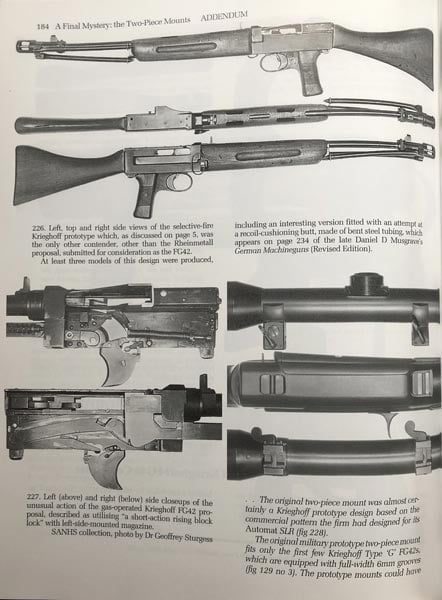
Enlisted FG42-1

Enlisted FG42-2
https://www.landmarkscout.com/fg-42-fallschirmjagergewehr-42-german-paratrooper-rifle/

FG42 Prototype

FG42-3
Prototypes
[edit]
Six manufacturers were solicited for prototype designs: Gustloff-Werke, Mauser, Johannes Großfuß Metall- und Lackierwarenfabrik, C.G. Hänel, Rheinmetall-Borsig and Heinrich Krieghoff Waffenfabrik.[8][12] Several contracts were awarded but only a few prototypes are known to have been submitted. Mauser offered a version of the MG 81 (rejected due to excessive weight and its belt-fed operation)[14] while Krieghoff presented a rising-block prototype, which too was quickly dropped. A design credited to Rheinmetall-Borsig’s Louis Stange of Sömmerda who had previously worked on the MG 34 proved satisfactory and underwent military trials conducted by the GL/C E-6 test station at Tarnewitz in mid-1942.[8] This early prototype, known under the factory designation Gerät 450 (“device 450”) or Ausführung “A” (“type A”), was intended to be a pure sheet metal design, using pressed steel in the construction of the receiver, buttstock and corrugated handguard. The proposed system of operation was modeled on that used in World War I Lewis light machine gun, with a gas-operated turning bolt action geared to a spiral (clock-type) recoil spring.[15] The type “A” was never produced beyond model form, but the basic design layout was retained for further development.[16]
With the basic characteristics of the LC-6 accepted, a series of modifications followed. The revised Ausführung “B” replaced the sheet metal handguard with a resin-impregnated fiber type that provided protection against heat and a better grip when wet.[16]
These tests exposed several shortcomings, addressed by Stange in April 1942 with the LC-6/II prototype. The prototype was then submitted to a series of endurance tests led by the HWA and further modified to increase functional reliability and durability, resulting in the final LC-6/III prototype variant that was ultimately accepted into production as the FG 42. Fifty rifles were fabricated by Rheinmetall-Borsig for evaluation purposes by the end of 1942.
A pre-series batch of 50 rifles was produced in early 1943 and 6 examples were sent to GL/C E-6 for additional testing. Almost identical to the LC-6/III, these guns differ from later models by using a smooth sheet metal buttstock and an experimental muzzle brake. The weapons experienced serious malfunctions: one rifle suffered a catastrophic failure after firing only 2,100 rounds, a soldier was injured when attempting to fire a rifle grenade and the pressed metal buttstock would deform after launching a small number of rifle grenades.


